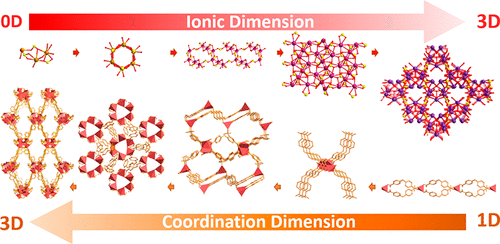当前位置:
X-MOL 学术
›
Cryst. Growth Des.
›
论文详情
Our official English website, www.x-mol.net, welcomes your
feedback! (Note: you will need to create a separate account there.)
Roles of Alkali Metals and Ionic Networks in Directing the Formation of Anionic Metal–Organic Frameworks
Crystal Growth & Design ( IF 3.2 ) Pub Date : 2020-09-11 , DOI: 10.1021/acs.cgd.0c00827 Anh N. Hong 1 , Huajun Yang 2 , Angel Zhou 1 , Xianhui Bu 2 , Pingyun Feng 1
Crystal Growth & Design ( IF 3.2 ) Pub Date : 2020-09-11 , DOI: 10.1021/acs.cgd.0c00827 Anh N. Hong 1 , Huajun Yang 2 , Angel Zhou 1 , Xianhui Bu 2 , Pingyun Feng 1
Affiliation

|
Integrating different types of fundamental chemical interactions to direct the self-assembly processes and to control the dimension of the network formed by each type of interactions is a promising strategy to develop advanced functional materials. Here, the ionic interaction of alkali metals (Na, K, Cs) toward multifunctional 2,2′-disulfo-4,4′-oxidibenzoic acid is utilized in two solvent systems, aqueous-amide and uro-amide, to synthesize six novel anionic framework materials with dramatically different features and dimensionalities: (Na3[Zn4O(L4–)3(e-murea)(H2O)3](H2N(CH3)2+)3(CPM-s1), [Zn4O(L4–)3(DMF)]((NH2(CH3)2+)6)(CPM-s2), Na6[(Zn2OH2)3(L3–)6](H2O)3(CPM-s3), K3[Zn2(L4–)2](H2N(CH3)2+)(e-murea)2(H2O)3(CPM-s4), K4[Zn(L3–)2](H2O)2(CPM-s5), and Cs6[Zn(L4–)2](H2O)2(CPM-s6), L4– = 2,2′-disulfo-4,4′-oxidibenzoate, DMF = N,N-dimethylformamide, e-murea = 1,3-dimethyl-1–2-imidazolidinone). In CPM-s1 to CPM-s6, the alkali-sulfonate ionic bonding networks transformed from zero-dimensional clusters with Na+ to one-dimensional (1D) chains and two-dimensional sheets with K+, and a three-dimensional (3D) network with Cs+. These vastly differing ionic domains influenced the coordination modes and spatial arrangements of the metal-carboxylate linkers, which consequently, directed the dimensionality of the coordination networks from 3D with Na+ to 1D with Cs+. CPM-s1 and CPM-s2, made from tetrameric Zn4O clusters, are rare examples of anionic MOF-5-type structures. CPM-s3 features an unprecedented hexameric Zn6 cluster. Even though a large portion of the charge-balancing cations in these materials would hamper hydrogen bonding networks, some of them still exhibit very high ionic conductivity (e.g., 1.25 × 10–3 S cm–1 in CPM-s3), suggesting the potential of these materials as solid-state electrolytes.
中文翻译:

碱金属和离子网络在指导阴离子金属-有机骨架形成中的作用
集成不同类型的基本化学相互作用以指导自组装过程并控制由每种类型的相互作用形成的网络的尺寸是开发高级功能材料的有希望的策略。在这里,碱金属(Na,K,Cs)对多功能2,2'-二磺基4,4'-氧化苯甲酸的离子相互作用被用于两种溶剂体系,即酰胺水溶液和尿酰胺,以合成六种新型具有明显不同的特征和尺寸的阴离子骨架材料:(Na 3 [Zn 4 O(L 4–)3(e-murea)(H 2 O)3 ](H 2 N(CH 3)2 +)3(CPM-s1),[Zn 4 O(L 4–)3(DMF)]((NH 2(CH 3)2 +)6)(CPM-s2),Na 6 [(Zn 2 OH 2)3( L 3–)6 ](H 2 O)3(CPM-s3),K 3 [Zn 2(L 4–)2 ](H 2 N(CH 3)2 +)(e-尿素)2(H 2 O)3(CPM-s4),K 4[Zn(L 3–)2 ](H 2 O)2(CPM-s5)和Cs 6 [Zn(L 4–)2 ](H 2 O)2(CPM-s6),L 4– = 2 ,2'-二磺基-4,4'-氧化苯甲酸酯,DMF = N,N-二甲基甲酰胺,电子尿素= 1,3-二甲基-1–2-咪唑啉酮。在CPM-s1到CPM-s6中,碱金属磺酸盐离子键合网络从具有Na +的零维簇转变为一维(1D)链和具有K +的二维薄片,以及三维(3D)与Cs +网络。这些截然不同的离子域影响金属-羧酸盐连接基的配位方式和空间排列,因此,将配位网络的尺寸从3D和Na +转变为1D和Cs +。由四聚Zn 4 O团簇制成的CPM-s1和CPM-s2是阴离子MOF-5型结构的稀有实例。CPM-s3具有前所未有的六聚Zn 6簇。即使这些材料中的大部分电荷平衡阳离子会阻碍氢键网络,但其中一些仍显示出很高的离子电导率(例如,CPM-s3中为1.25×10 –3 S cm –1),这表明了潜在的潜力。这些材料作为固态电解质。
更新日期:2020-10-07
中文翻译:

碱金属和离子网络在指导阴离子金属-有机骨架形成中的作用
集成不同类型的基本化学相互作用以指导自组装过程并控制由每种类型的相互作用形成的网络的尺寸是开发高级功能材料的有希望的策略。在这里,碱金属(Na,K,Cs)对多功能2,2'-二磺基4,4'-氧化苯甲酸的离子相互作用被用于两种溶剂体系,即酰胺水溶液和尿酰胺,以合成六种新型具有明显不同的特征和尺寸的阴离子骨架材料:(Na 3 [Zn 4 O(L 4–)3(e-murea)(H 2 O)3 ](H 2 N(CH 3)2 +)3(CPM-s1),[Zn 4 O(L 4–)3(DMF)]((NH 2(CH 3)2 +)6)(CPM-s2),Na 6 [(Zn 2 OH 2)3( L 3–)6 ](H 2 O)3(CPM-s3),K 3 [Zn 2(L 4–)2 ](H 2 N(CH 3)2 +)(e-尿素)2(H 2 O)3(CPM-s4),K 4[Zn(L 3–)2 ](H 2 O)2(CPM-s5)和Cs 6 [Zn(L 4–)2 ](H 2 O)2(CPM-s6),L 4– = 2 ,2'-二磺基-4,4'-氧化苯甲酸酯,DMF = N,N-二甲基甲酰胺,电子尿素= 1,3-二甲基-1–2-咪唑啉酮。在CPM-s1到CPM-s6中,碱金属磺酸盐离子键合网络从具有Na +的零维簇转变为一维(1D)链和具有K +的二维薄片,以及三维(3D)与Cs +网络。这些截然不同的离子域影响金属-羧酸盐连接基的配位方式和空间排列,因此,将配位网络的尺寸从3D和Na +转变为1D和Cs +。由四聚Zn 4 O团簇制成的CPM-s1和CPM-s2是阴离子MOF-5型结构的稀有实例。CPM-s3具有前所未有的六聚Zn 6簇。即使这些材料中的大部分电荷平衡阳离子会阻碍氢键网络,但其中一些仍显示出很高的离子电导率(例如,CPM-s3中为1.25×10 –3 S cm –1),这表明了潜在的潜力。这些材料作为固态电解质。











































 京公网安备 11010802027423号
京公网安备 11010802027423号